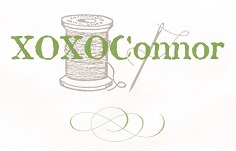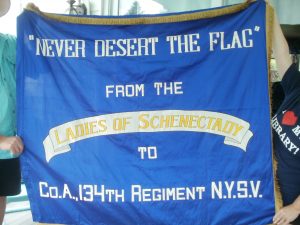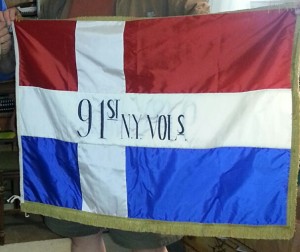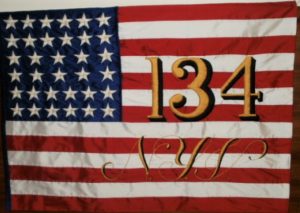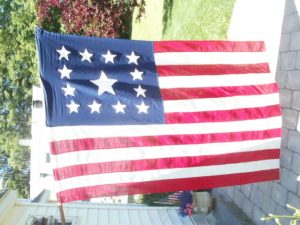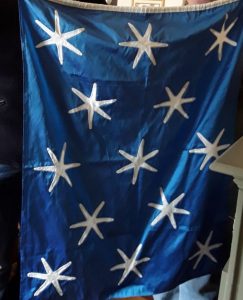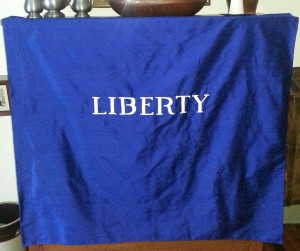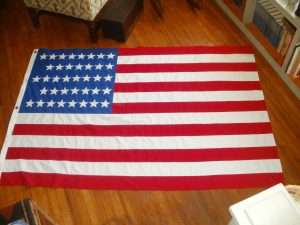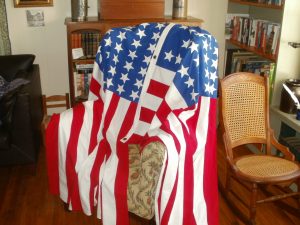Reproduction Flags
Throughout history, flags have identified their bearers as they claimed new lands, crossed oceans, met in battle, or represented their nation. Few items in living history today better symbolize eras gone by than the standard of a people’s spirit, military unit, province, state or nation. The colonial period of New York saw its fair share of colorful flags from the Dutch West India Company at Manhattan and Fort Orange in the 1620’s, to, perhaps, the first stars and stripes ever unfurled at Fort Schuyler (aka Stanwix) in August, 1777. In between were a host of national French, Dutch, and English flags, not to mention the provincial and military flags that were carried in their motherlands’ honor.
Some of these historic flags are well known and examples are even on display in museums, while others need research to find adequate descriptions to reproduce with reasonable accuracy. Things common to all flags in the colonial period, though, is that they were all made of natural fabrics, usually made of spun wool or silk. They were also hand sewn. Designs, such as stars, eagles, crosses, etc, were added by several different methods that included appliqué, embroidery and paint. No one in the colonial period, at least in the colonies, exclusively made flags simply because there was not enough of a demand to support a business or family. Normally, a person known for sewing prowess would be contracted to sew a flag together and could usually handle any embroidery or appliqué work needed. For more elaborate painted designs, a local artist might be sought out who could complete the desired concept. Luckily, Pam is a very talented artist who happens to have a master’s touch with sewing. We would be hard-pressed to think of a flag she could not reproduce.
Pam reproduces flags in the way they ought to be done – hand-sewn and true to the original. Descriptions found in documents and any existing photographs will be used to help determine the fabric, color and design needed to re-create a flag with reasonable accuracy. Where there are gaps in the documentary evidence, general practices of the day will be used. Re-created military units know their standards and needs best, so they are encouraged to provide as much detail as they can. In some cases, we are able to provide some assistance with determining which unit or regimental flags might be appropriate, with the goal being to produce a flag the unit will be proud to bear. Whether you need a flag for your re-created military unit, a living history program, to add a colorful visual to a museum exhibit, or just a conversation piece for your living room, you can expect a high quality reproduction that can stand the “is it hand made?” scrutiny of the re-enactment community.
Pam’s flag clientele transcends any particular era. She has made flags from the 17th, 18th and 19th centuries. Two of her flags, ca. 1887, will soon be seen in the second season of an HBO series called “The Gilded Age.” Another will be featured in an Amzaon prime series based on the popular video game “Fallout”. In fact, Pam can make just about any flag from any era based on existing documentation or providing additional research if needed.
Prices may vary depending upon the amount of labor; typically, the more elaborate the design, the higher the cost. Contact us HERE to discuss pricing for a flag you would like to own. See below for samples of flags Pam has made for clients.
Gallery
Click to enlarge and view full descriptions
- Silk flag presented to Company A of the 134th Regiment, NYS Volunteers by the Ladies of Schenectady when the regiment arrived at Albany, NY prior to departing to join the Army of the Potomac in September, 1862. From newspaper descriptions. The original was cut up so each surviving soldier of the regiment could take a piece home at the end of the war. No known photograph exits.
- The original silk battle flag reproduced here is found in the NYS Military Museum and Veterans Research Center in Saratoga. This is a regimental flank marker of the 91st Regiment of NY Volunteers, which was recruited from the Albany Capital District area from 1861 – 1865. A photograph of the original can be found at https://dmna.ny.gov/historic/btlflags/infantry/91stInfMarker.htm
- Silk guidon, or flank flag of the 134th Regiment, New York State Volunteers, recruited in Schoharie and Schenectady Counties and mustered in at the Village of Schoharie. From the original in the New York State Military Museum and Research Center at Saratoga, NY. Visit the link https://dmna.ny.gov/historic/btlflags/infantry/134thInfGeneralGuideFlags.htm
- Wool 13 star flag depicted on the Jonathan Trumball painting of the Surrender of Yorktown
- Washington’s position, or Head Quarters flag. Silk. An original is found in the Museum of the the American Revolution at Philadelphia. Visit the link at https://www.amrevmuseum.org/press-room/press-releases/george-washingtons-headquarters-flag-be-displayed-philadelphia-first-time
- Silk Liberty Flag, based on the discolored silk flag found in the Schenectady County Historical Society collection. Documents variously describe a blue, green or blue-green color. One client requested the blue you see here. Another requested blue-green. Click to enlarge
- One of two cotton flags made for the HBO series “The Gilded Age” , ca. 1887. There are 38 stars, leaving two blank spaces in the canton so additional stars can be added for new states.
- Both flags made for the HBO series “The Gilded Age.” The larger one was requested for outdoor shots and the smaller one for the interior courthouse shots.
For more information, availability and prices of items shown, and all other inquiries, please go HERE



